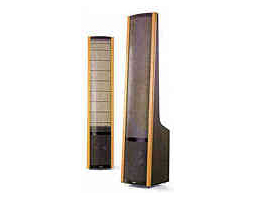There is also the choice of Super-VHS, Hi-8, and DV. Regular VHS, which is the standard in VCR recording, has a resolution of 240 lines. This is called the “horizontal resolution” and refers to being able to show 240 VERTICAL lines on a section of the TV screen that is equal in width to the height of the screen (a square). If the subject has more than 240 vertical lines (alternating white and black lines) that would be shown in this square, then the lines would blend together (appearing as gray) and not be distinct as individual lines. This is the essence of resolution, being able to distinguish two objects (lines or dots) as two, instead of their blending together at the edges to appear as one. Standard NTSC live broadcast TV has a horizontal resolution of 330 lines, broadcasts from video tape have about 300, and laserdisc has 420. Super-VHS and Hi-8 also have 420 lines of resolution, although the picture is not quite as good as laserdisc, illustrating that there are more factors than just resolution that go into making a video image.
Note that the previous discussion of NTSC TV exhibiting 483 horizontal lines represents vertical resolution, not horizontal, a  fact that has confused many people (including the author). When looking at television specifications, it will say something to the effect that it is “capable of 700 lines of resolution”. Again, this refers to horizontal resolution (capability of showing 700 vertical lines). However, since no current signal sources go above 480 lines (DVD) – see discussion of DV below – this resolution specification is only relevant when considering the fact that, the more resolution capability the TV has, the easier it will be for the TV to show a sharp image within the normal 240 – 480 lines of resolution that the various sources have.
fact that has confused many people (including the author). When looking at television specifications, it will say something to the effect that it is “capable of 700 lines of resolution”. Again, this refers to horizontal resolution (capability of showing 700 vertical lines). However, since no current signal sources go above 480 lines (DVD) – see discussion of DV below – this resolution specification is only relevant when considering the fact that, the more resolution capability the TV has, the easier it will be for the TV to show a sharp image within the normal 240 – 480 lines of resolution that the various sources have.
A standard VHS tape costs, when purchased in bulk quantities (package of 8 tapes) at one of the discount stores, about $2.50 for a two hour length (called T-120). An extended length tape (called T-160) which works well for movies longer than two hours, costs about $5.00. Super-VHS and Hi-8 tapes cost about $8.00 for the two hour length. (Lower prices can be obtained by mail order.) If you make home videos using the Super-VHS format camcorders or Hi-8 camcorders, then you should purchase a Super-VHS or Hi-8 VCR. Also, for digital satellite systems, if you want to take full advantage of the high resolution on many of their broadcasts, Super-VHS or Hi-8 are the only way to go. Super-VHS VCRs will play standard VHS tapes as well (Hi-8 tapes are about the size of audio cassette tapes), automatically sensing their presence in the machine (most movie rental tapes are in the standard VHS format). If you purchase a Super-VHS or Hi-8 VCR, there will be at least one S-Video output in the back (S-Video carries the chroma and luminance separately, while composite video has them combined). This will be connected either to the S-Video input on your TV or to your surround sound receiver. If you have a laserdisc player as well, then it is important that the TV or surround sound receiver have at least two S-Video inputs.
Although some experimentation has been done using Super-VHS, it is not feasible at present to encode AC-3 (Dolby Digital – DD) onto regular VHS tapes (VHS, Super-VHS, and Hi-8 are analog devices). There are a few D-VHS VCRs available, and they will record digital video, but not HDTV. Digital Video cameras (DV Camcorders) are commonly available, and they have 500 lines of horizontal resolution, although practically speaking, they only resolve about 480. DV VCRs, also having 500 lines of resolution, can be used to play the DV tapes back and to do editing. Blank tape for these are very expensive, so it is not very economical to store movies on them, even if copy protection on DVDs were not enabled.


